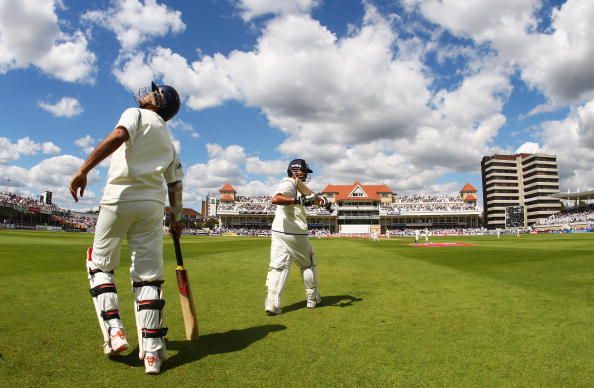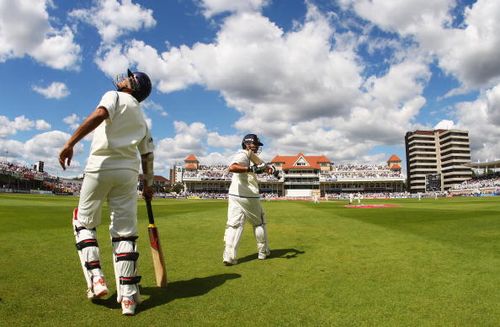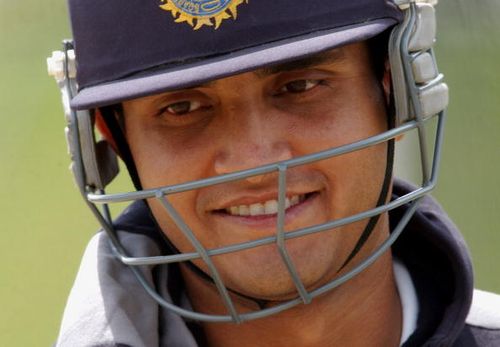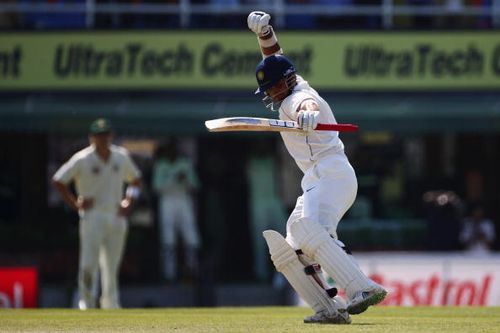
Sourav Ganguly - Not just a cricketing hero

“I like it when a flower or a little tuft of grass grows through a crack in the concrete. It’s so heroic.” ? George Carlin
Triumph against odds has always fascinated us. That is why in movies we invariably root for the underdog who is able to defy all odds and prove to be a winner. We hail him as a hero. Perhaps we are able to relate to such characters. Their tale of resilience in the face of adversities of seemingly insurmountable proportion gives us the belief that if they can do it, so can we.
When we come across such individuals in real life, we start idolising them. Their personality and aura transcends their achievement in a particular field or particular domain. For Bengalis, Sourav Ganguly is one such hero.
I have observed that most of my friends outside Bengal have struggled to fathom the reason that gave Ganguly the cult status that he enjoyed at Eden Gardens. The two most notable incidents of such mass hysteria being the ODI against South Africa, in which the entire Eden Gardens rooted for the Proteas, and the recent IPL encounter between Kolkata Knight Riders and Sourav-led Pune Warriors.
Majority of them believed that match (on 5th of May) between Sourav’s side (Pune Warriors India) and Kolkata (Kolkata Knight Riders) was overhyped. The nature of IPL is such that in many instances a local favourite might be representing a franchisee from a different city. Harbhajan Singh, Rahul Dravid and Gautam Gambhir have led their adopted franchise against their home city team in this very edition of IPL. So why so much hype, so much discussion on one man?
It can partly be attributed to the emotional nature of Bengalis but it was more than just that. Listed below are certain factors that have given Sourav a cult image in his region.
No other famed cricketer from the city: This is perhaps the most obvious reason that even readers from other parts of the country also comprehend. While Rahul Dravid might be the favourite son of Bangalore, they were also blessed to call Anil Kumble, Srinath and Prasad as their own sons. Similarly, Delhi had Sehwag, Gambhir and to a certain extent Akash Chopra representing them at the national level. But for Bengal there was the one and only Sourav Ganguly.
Bengal, over the years, has had a culture of being sports aficionados. And Football and Cricket happens to be the most loved sports. In football, Bengal’s dominance has been pretty consistent. Being champions on 29 occasions (and runners up 11 times) out of the fifty five editions of Santosh Trophy provides ample testimony to that. However the same cannot be said about our cricketing triumphs. And neither did Bengal have a legacy of producing world class players in the only game where India competes at the international stage with some distinction.
Sourav Ganguly fulfilled that latent desire of entire Bengal of being a truly world class player. And ironically many believe that it was his stint as the captain of the national squad that started transforming India from just a bunch of quality players to a quality team.
Void of local heroes in the 90s: If we look back at Bengal’s history, it has always been graced by illustrated dignitaries who have been the vanguards in their respective fields at the national level. Personalities whom the entire country would look up to. So if Rammohan Roy and Vidyasagar were pioneers in modernizing Hindu Society, the likes of S. N. Banerjee, B.C.Pal, M.N. Roy and S.C. Bose were stalwarts of the Indian freedom movement. Post independence Bengal was blessed to have eminent film and music luminaries like Bimal Roy, Hrishikesh Mukherjee, Kishore Kumar, and the father son duo of Sachin Dev Burman and Rahul Dev Burman. And Satyajit Ray.
If we look at the period between 1990 to 2010, a lot has happened in India. Our economy was opened up. We became a nuclear power country. IT revolution swept the whole country. Our economy took giant steps en-route becoming the fourth largest economy in the world. New heroes emerged. Dr. Manmohan Singh, Dr. Abdul Kalam, Atal Behari Vajpayee, Narayan Murty are some of the most prominent examples of the same. However amidst all these hype, Bengal somewhere down the line got left behind. It did not open itself to the IT wave in the 1990s and in the 2000s, was left to do the catching up job. Similarly owing to the perception of poor work culture, even its economy and job creation could not keep pace with the likes of Mumbai, Delhi, Bangalore and Hyderabad. It was a far cry from the days of Tilak who had once stated ‘What Bengal thinks today, India thinks tomorrow’ and even the days of 1960s when maximum number of companies in India used to have their registered office/head office in Kolkata.

The only notable exception was the field of cricket. In the summer of 1996 a certain bespectacled Sourav Ganguly announced his arrival at the world stage by scoring a debut century at the hallowed portals of Lords. Subsequently, he not only went on to represent India in over a hundred tests and 300 ODIs, he also went on to become one of the best captains India has ever produced. Not only does he still hold the distinction of winning most number of matches as the Indian Skipper, the players who emerged during his tenure played a stellar role in India’s triumph in the World Cup in 2011. Thus Sourav emerged as the only figure in these two decades whom Bengalis can feel proud of. Somebody who served as an apt reminder to the rest of the country, that Bengal still exists.
Perceived sense of injustice: In 2009, before the Lok Sabha elections when Sitaram Yechury visited Kolkata for campaigning, he had told in a media conference that only if a third front government comes to power will we witness a Bengali Prime Minister. Through this statement he took a dig at Congress for not supporting the candidature of Pranab Mukherjee, as the Prime Minister of the country. This perception of injustice or being left out is quite deep rooted in the psyche of Bengalis and it is not restricted to only the dirty world of politics.
The most notable instance of this is of course Subhas Chandra Bose. Such was his acceptance within the Congress that he was able to defeat a Gandhi-nominated candidate and become the president for a second successive year in the late 1930s. However the Gandhi faction refused to cooperate with Bose, as a result of which he had to leave Congress in the early 1940s. Thereafter he formed his own party, formed a pan India army that was not divided along regional lines, included women in his troops and his leadership qualities came in for praise from even Adolf Hitler. But a leader of this magnitude is sadly forgotten in India. While Gandhi and Nehru’s birthday is celebrated across the length and breadth of the country, Bose’s birthday is feted in only West Bengal and Punjab.
Cut to the world of cricket. Anil Kumble had once remarked that Venkatpathy Raju was the best spinner among his contemporaries in the Indian National Team. If you compare Raju’s career with another left arm spinner of the same era, it could make for some interesting stats. The player in contention is Utpal Chatterjee. Both Raju and Chatterjee had played over a hundred first class matches for their respective team and both of them took over five hundred wickets. However Chatterjee has decisively a better strike rate and better bowling average than Raju in both first class and List A Matches. Also, they both played in the same era against same oppositions and the pitches in Kolkata and Hyderabad are very similar (as has been testified by both Laxman and Md. Azharuddin), which I guess do a fair job in portraying the guile and capability of these two left arm spinners. Throw in the fact that Chatterjee was a more accomplished batsman than Raju (a better batting average and a first class century) and I guess Utpal Chatterjee and the whole of Bengal has reasons to believe that he was hard done by the selectors. For the records, Raju featured in 28 tests and 53 ODIs while Chatterjee had to be content with 3 ODI appearances.
Similarly, Sunil Gavaskar had mentioned in one of his books that Gopal Bose deserved a chance to don the national cap. Sadly the selectors felt otherwise; in an era when India struggled to find a suitable opening partner for Gavaskar.
Sourav Ganguly was also destined for neglect. He was overlooked for a period of 5 years after failing in a solitary ODI. But he fought his way back in the team and went on to become one of the greatest players for India. Then again he fought back his place in the side in the mid 2000s when the team management looked determined to write his obituary. It is this refusal to cow down in the face of adversity that made Sourav special; he served as the real life example of Rambo in the Rocky series and once again his sphere of influence was not restricted to the cricket crazy people of Bengal.

Ganguly, the individual: As much as all the circumstantial factors were responsible, there is no denying the fact that Ganguly himself did no harm to establish the cult status that he enjoys. In the tour of England back in 1996, his selection itself came in for a lot of criticism from different corners, ranging from Pataudi to Bishan Singh Bedi. They snubbed his selection as an outcome of regional bias in team selection and urged the selectors to show more national commitment while selecting a side that is meant to represent the country. How well did Ganguly reply to all his detractors by scoring two back to back centuries in his first two tests, the first one being at the Mecca of Cricket. Surely, the man knew a thing or two about timing.
And it is this gift of timing that stood him in good stead for a period that encompassed a decade – a time frame in which he went on to become the second most prolific run getter of India after Sachin Tendulkar in ODIs, both in term of the runs scored and centuries made. In the same vein, he went on to represent India in more than 100 tests and scored more than seven thousand runs in that format as well. After he was dropped in mid 2000s, he made a strong comeback and played a very decisive part in India’s triumph in England in 2007. Even in his last series against Australia he scored a century. His last innings score was identical to that of the legend Don Bradman. Has anyone scored a more glorified duck? Surely his feats as a batsman were savoured by his fans from all across the globe.
But perhaps what out-dazzled Sourav the batsman was Sourav the Captain. He took over the mantle of captaincy at a time when India had lost 5 tests in a row, including a series in India. Dark clouds of match fixing were hovering in the horizon and the future of Indian cricket looked gloomy. But this man proved once again that he loved challenges and thrived under pressure. India started winning test matches abroad with some degree of consistency. Even when we were not winning them, we were always putting up a strong fight. He taught Indians to look in the eyes of the opposition and to trade blow for blow on the cricket field. His bare bodied chest thumping celebrations have become a part of Indian cricket folklore. Most importantly, he taught Indian players to play as a team; the coinage ‘Team India’ acquired a certain degree of credibility when he was at the helm of affairs.
It is difficult for any ethnic group to not feel proud of a son as unique as Sourav. And Bengal was no exception. Every time the ball hit the middle of his bat, the sound of his willow echoed the voice of 9 crore Bengalis. His triumphant run after picking up a wicket gave the people of his region an opportunity to bask in glory in an era when they had little to celebrate. And his phoenix-like ability to stage a comeback every time gave a fillip of hope to his entire region that it is never too late to turn things around. Needless to say that his bands of followers are not restricted by any geographical border, but for a region that was going through particularly difficult times, his feats were that much more special.
And that is what caused the dilemma to an average Kolkatan on 5th of May- whether to support the city they loved or whether to support the man who made them love the city.